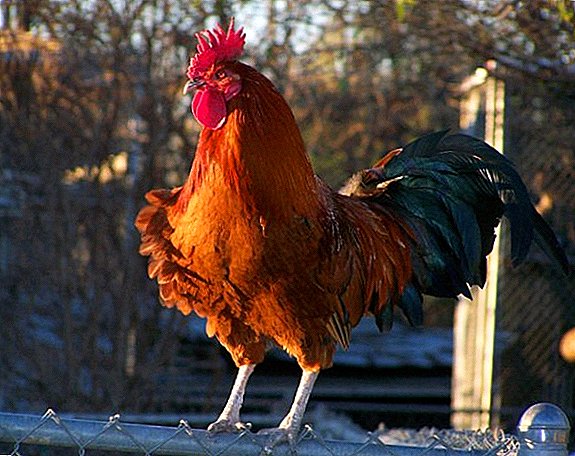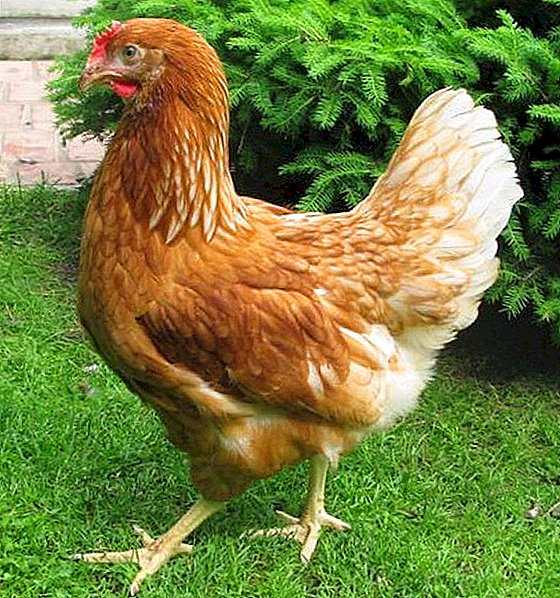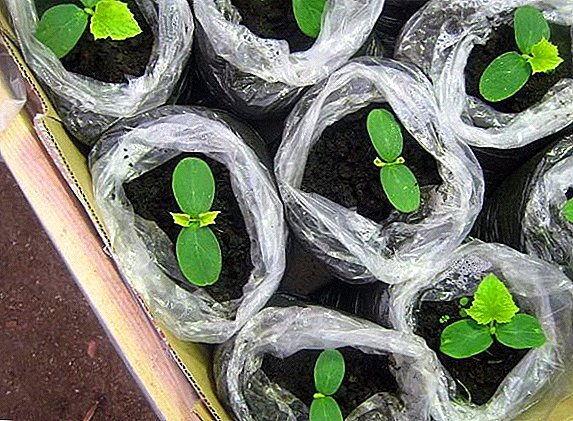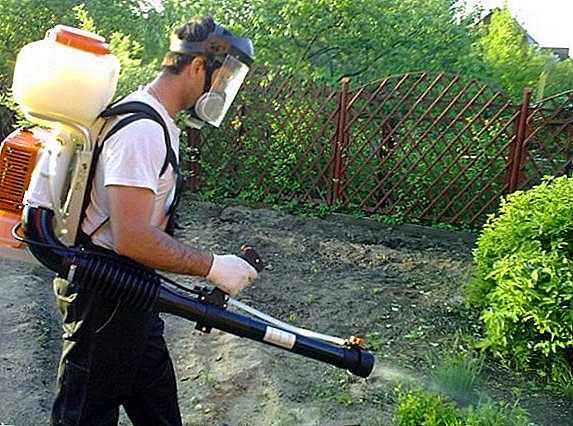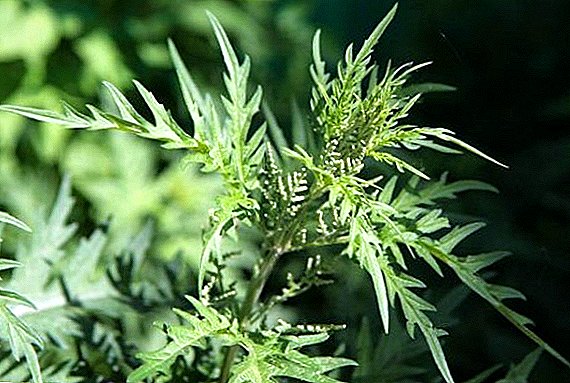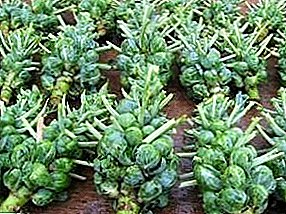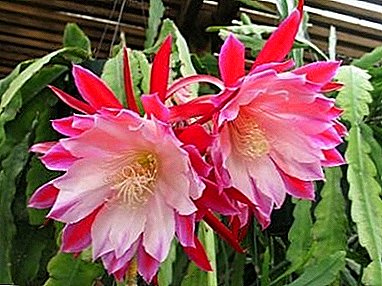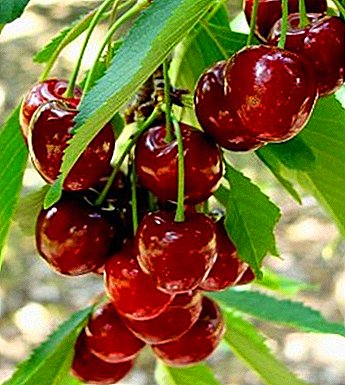
The beauty and the unforgettable aroma of cherry orchards during the flowering period have often been admired by poets who describe this amazing phenomenon in a variety of bright and expressive colors.
Indeed, this slender, graceful tree, with proper planting and care can give a lot of joy to its owner.
In the spring, these are delicate flowers that fill the surrounding space with their fragrance, in the summer - juicy, ruby berries, a real precious decoration of any garden, and, of course, delicious jams and compotes, giving a lot of pleasure to adults and children.
In short, cherry is a plant that is more than worthy to be in any garden, from the southern zones to areas with a temperate and cool climate. For this reason, she deservedly enjoys love from many gardeners who grow it on their plots.
Currently, a sufficiently large number of varieties of cherries, intended for cultivation in various conditions.
One of them is the Belarusian variety of cherries Vianok, which is distinguished by unpretentiousness and high yield, a full description of the characteristics and photos of the fruit later in the article.
Breeding history and breeding region
 The copyright for the breeding of this variety belongs to the team of the Institute of Horticulture of the National Academy of Sciences of Belarus, namely, its employees: E.P. Syubarova, R.M. Sulimova, M.I. Vyshinskaya and TS Wide
The copyright for the breeding of this variety belongs to the team of the Institute of Horticulture of the National Academy of Sciences of Belarus, namely, its employees: E.P. Syubarova, R.M. Sulimova, M.I. Vyshinskaya and TS Wide
It was used as the parent instance. grade "Novodvorskaya".
In Russia, for its state-assisted testing, “Vyanok” was introduced in 2004, where, thanks to its excellent taste characteristics, high yield and winter hardiness, it quickly became very popular literally in the first few years after its appearance.
Popular varieties of cherries such as Morozova Dessert, Generous and Zhukovskaya are also popular.
Appearance Cherry Bream
Consider separately the appearance of the tree and fruit.
Tree
"Vyanok" refers to grades of felt type universal purpose of the average term of maturing. Trees differ rather tall and large, have a slightly elevated crown of medium thickness, pyramidal shape. The height of adult plants ranges from 2.5 to 3.0 m.
Kharitonovskaya, Fairy and Chernokorka also belong to the felt varieties.
Fruit
The fruits of this cherry not very large, the average weight of berries is about 4 grams, round, smooth, brilliant, rich burgundy hue. Separation from the stem - easy, without moisture.
 Stone - small, approximately 3.1 - 5% of the total mass of the fetustaken out without effort.
Stone - small, approximately 3.1 - 5% of the total mass of the fetustaken out without effort.
The dark red flesh is distinguished by medium density, high juiciness, has a pleasant taste with sourness.
The color of the juice refers to the griots or moreli, having juice of a dark color. Tasting assessment of fruits - 4.5 points. This group also includes the Griot of Moscow, Volochaevka and Vladimirskaya.
Fruiting plants occurs from the third year of his residence in a permanent place of residence. Full ripening occurs in the middle of summer (in July).
A photo







Characteristics of a variety
One of the main advantages of the variety "Bream" is its good taste. The chemical composition of its fruit is as follows:
| amount | Composition |
|---|---|
| Mass fraction of dry matter | 11,4 % |
| Titrated acids | 1,1 % |
| Sahara | 7,82 % |
| Vitamin C | 5.2 mg / 100 g |
| Pectin | 0,47 % |
In addition, it has a very high yield of about 13 tons per hectare.
High yields are demonstrated by Black Large, Nadezhda and Rossoshanskaya Black.
This result gives landing scheme 5 x 3 musing wild cherry rootstocks, and good winter hardiness, allowing the tree to safely endure long-lasting negative temperatures, including quite low ones.
Thanks to its self-fertility the variety has the ability to tie more than 20% of the ovaries when pollinating with its own pollen. In addition, it is an excellent pollinator for other varieties.
Mayak, Novella and Yenikeev Memories also possess self-fertility.
Helpful advice: The future harvest of cherries largely depends on the proper gathering of berries. If you cut them in bunches, you can damage the bouquet branch, on the state of which the subsequent fruiting of the tree depends.
Among the positive qualities of the variety "Windmills" is also worth noting. resistance to diseases and pests. This cherry little sensitive to coccomycosis and moniliasis. Differs in simplicity and unpretentiousness in agrotechnology.
Resin, Tsarevna Felt and Morozovka also demonstrate unpretentiousness in cultivation.
Planting and care
In order for the cherry to feel well in the garden and annually bear fruit, compliance with its planting rules is of great importance. It is necessary to place young trees on the territory having good wind protection. The best variant of its location: small elevations in the southeast or southwest zone of the garden.
 Cherry is a good soil loamy and light sandy type, with good air and water permeability.
Cherry is a good soil loamy and light sandy type, with good air and water permeability.
When grown on heavy soils, it will grow slowly and yield much less yield.
Sandstone is also not very good for this plant.
Cherry has a growth retardation on them, which is why it does not have time to prepare for the winter period of time.
Peatlands are not suitable for planting because of their high acidity and coldness. That is, in this case the tree needs to conduct a whole range of additional agrotechnical measures.
The optimum indicator of soil acidity is 6.5 - 7.0, the depth of the location of groundwater is from 1.5 to 2.0 m.
- Landing
Cherry better fit spring planting. Landing pits are being prepared for this. dimensions of approximately 70 - 80 cm, with a depth of 60 cm.The bottom is covered with a layer of black soil with the addition of a small amount of compost or well-rotted manure (no more than 15-30 grams per tree). Wood ash or potash fertilizer is added there.
Important: not rotted manure, lime, nitrogen-based fertilizers in the pit when planting can not be made!
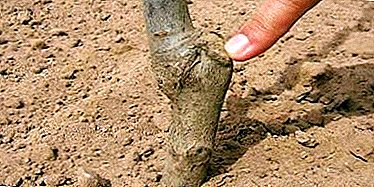 The root collar is located on the ground level, taking into account the fact that later it will settle down by about 2-5 cm.
The root collar is located on the ground level, taking into account the fact that later it will settle down by about 2-5 cm.The young tree needs to be cut. At the same time, the main branches and the conductor are shortened by 1/3 of their length.
- Top dressing
When the planting pit is properly “filled” in the first and second year of life, young cherries are fed with ammonium nitrate in the proportion of 15-30 g per tree barrel.
After the beginning of fruiting (for 3-4 years), 4-6 kg of organic fertilizers, 9 g of potassium and nitrogen and 6 g of phosphorus are added per 1 square meter of crown in the projection. This feeding is done once every 4 years.
In the fall, cherries are fed with phosphorus and potassium, bringing them when they dig in a tree. Foliar top dressings that can be used simultaneously with pesticides are also very effective for this culture.
- Watering
Cherry is very demanding to have enough moisture. Especially carefully it should be monitored during the period of its growth and ripening of fruits.
In the absence of precipitation, it is watered immediately after the flowering stops, somewhere in late May, early June, then, in the second half of June, 3-4 weeks after flowering, and in July, if necessary.
It should be remembered that excessive waterlogging during this period can lead to the fact that ripening berries will crack and lose their presentation.
In order for the cherry to endure the winter well, in dry weather it must be watered from September to early October. Irrigation rate: 50-60 liters per 1 square meter, to a depth of about 40 cm.
- Pruning
 To get a good harvest of tasty and fragrant berries, cherries need to be properly cut. Do this before the awakening of the kidneys, in the first days of spring. Trimming is carried out in two ways: by thinning or shortening.
To get a good harvest of tasty and fragrant berries, cherries need to be properly cut. Do this before the awakening of the kidneys, in the first days of spring. Trimming is carried out in two ways: by thinning or shortening.Thinning removes weak, diseased branches growing in the wrong direction. When shortening, part of the growth is removed, which is a stimulus for better plant growth. Trimming should not be too strong.
At the same time, the first 5-6 years trees are only molded to prevent weakening of the growth of young shoots and an increase in the time of fruit ripening.
Diseases and pests
Variety "Vyanok" is considered to be quite resistant to most diseases. And, most importantly, it is insensitive to its main enemy - coccomycosis, which manifests itself in the form of small spots of red-brown color appearing on the leaves and pinkish bloom - conidial sporulation, appearing on their underside.
As a result, the leaves dry and fall off, and when the disease is neglected, the leaves are shed in July, because of which the sore tree can not survive even a fairly mild winter.
The disease is caused by a fungus that lives in fallen leaves located on the surface of the earth around the plant. In the spring, his spores are spread through the garden and infect young leaves.
Resistance to coccomycosis can also boast Ashinskaya, Tamaris, Podbelskaya, and Lebedyanskaya.
To prevent the development of this disease, it is necessary to carry out complex processing of cherries in a timely manner. Their number should be at least 4 per year:

- 1st - in early spring, swollen kidneys. Contact action fungicides are used (Bordeaux liquid, made, copper oxychloride, etc.).
- 2nd - in the initial flowering time. Preparations of the system group ("Skor", "Topsin M").
- 3rd - immediately after its completion.
- 4th - two weeks after the 3rd.
Cherry can also be processed after harvesting berries, when it is attacked by aphids.
For best effect, the chemicals used must be alternated. It is also good to use a mixture of contact and systemic drugs or combine fungicides with insecticides against pests. Good combinations: "Skor", against coccomycosis and "Fufanon" from aphids.
In short, subject to the rules of planting and proper care, cherry "Vyanok" well take root in any garden. At the same time, it can be grown in regions with a rather cold climate. And then, following the simple rules of agrotechnology, maintaining the correct regime of fertilizing and watering, this wonderful culture will please every year with a rich harvest of aromatic, juicy and tasty berries.
If you are looking for a variety with early ripening, pay attention to the varieties of Morozova Dessert, Resin or Podbelskaya.
Watch the video about the variety of cherries.


 The root collar is located on the ground level, taking into account the fact that later it will settle down by about 2-5 cm.
The root collar is located on the ground level, taking into account the fact that later it will settle down by about 2-5 cm. To get a good harvest of tasty and fragrant berries, cherries need to be properly cut. Do this before the awakening of the kidneys, in the first days of spring. Trimming is carried out in two ways: by thinning or shortening.
To get a good harvest of tasty and fragrant berries, cherries need to be properly cut. Do this before the awakening of the kidneys, in the first days of spring. Trimming is carried out in two ways: by thinning or shortening.
